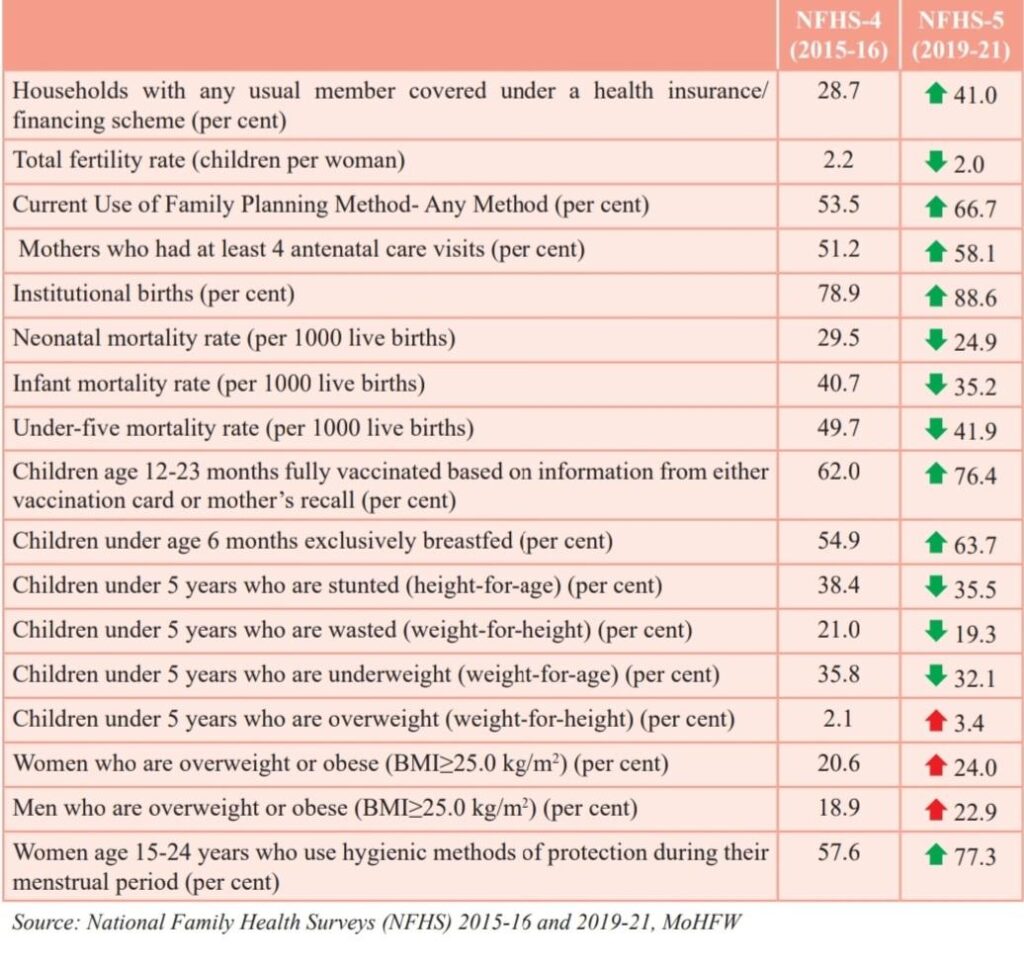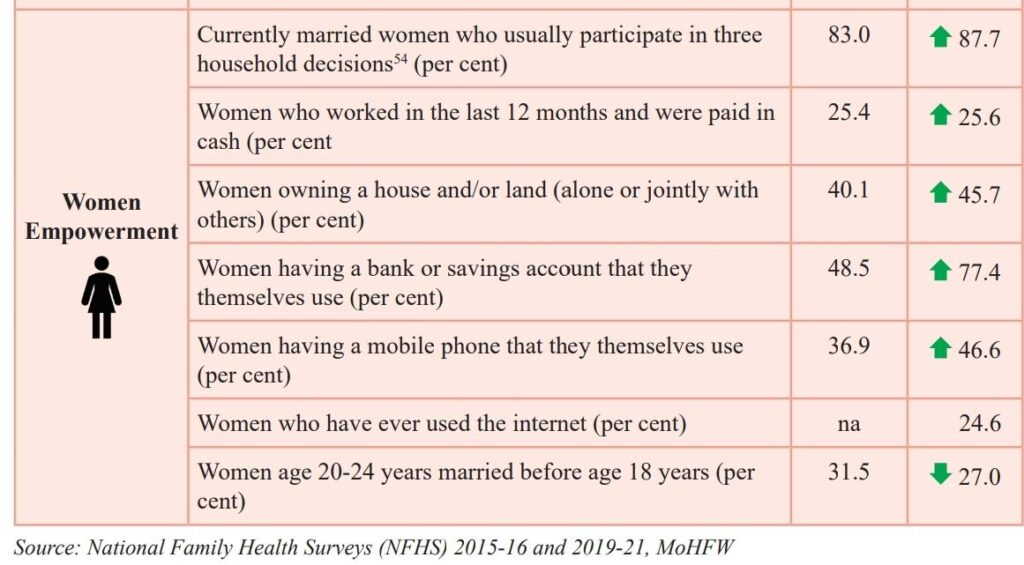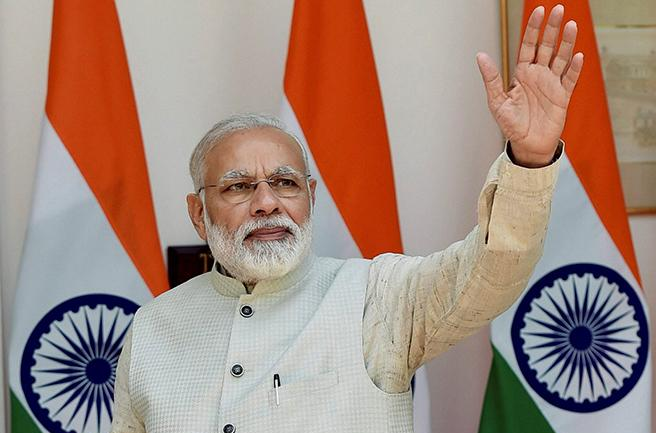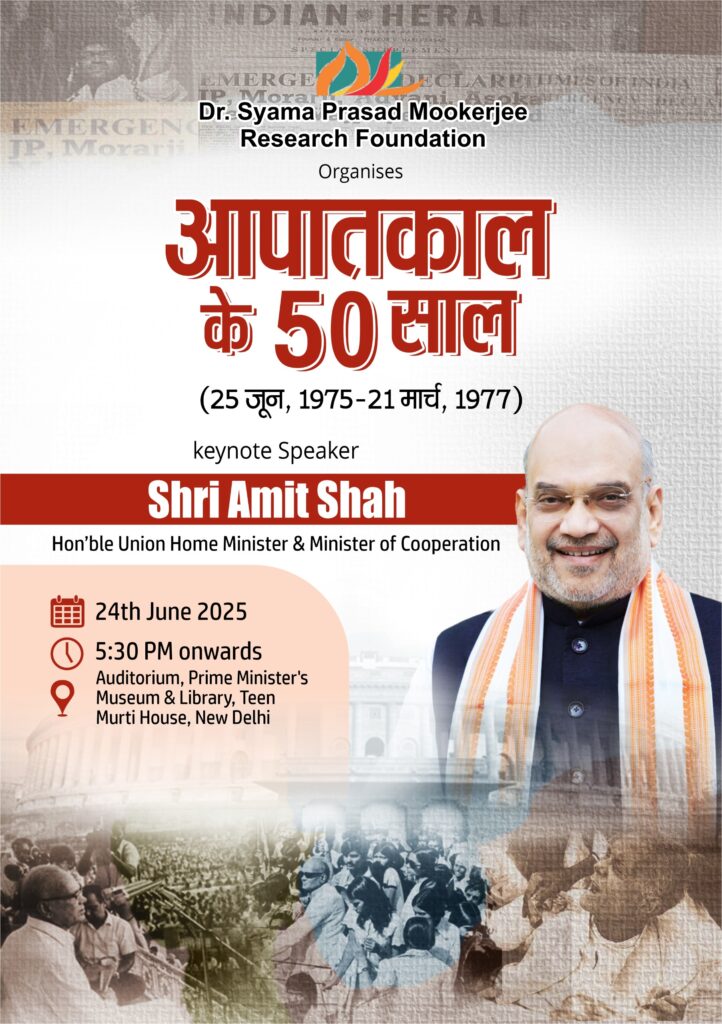तस्मादेताः सदा पूज्या भूषणाच्छादनाशनैः ।
भूतिकामैर्नरैर्नित्यं सत्कारेषूत्सवेषु च ॥ ५९ ॥
tasmādetāḥ sadā pūjyā bhūṣaṇācchādanāśanaiḥ |
bhūtikāmairnarairnityaṃ satkāreṣūtsaveṣu ca || 59 |
Manusmrithi 3.59
This famous sloka from Manusmrithi says that men who seek ( their own) welfare should always honor women on festivals with ( gifts of) ornaments, clothes, and food. Without the welfare of women, men cannot progress, and society will be in chaos. Our tradition has always given utmost respect to women. Liberals often misquote Manusmrithi as misogynistic and being against women. However, this smrithi which is one of the ancient sources of our Sanskar, made it mandatory for men to treat women with respect. For generations, our lives were inspired by these sets of ‘smritis’. However, the coming generations will venerate nine and half years of the Modi government as ‘ NAMOSMRITHI’.
‘Namosmrithi’ centered upon ‘Narishakthi’
Prime Minister Narendra Modi has reiterated in every address to the people the role of Narishakthi in the progress of our nation. He firmly believed that the empowerment of women is the bedrock of our society’s development and that their leadership, especially at the grassroots, is crucial for our inclusive and sustainable progress. Right from taking over office in 2014 to till date, PM Modi led Government of India, has been fully committed to realizing the vision of Narishakthi. From Swach Bharat to passing of women’s reservation bill in Parliament, this government has demonstrated the commitment it has to women’s empowerment. This commitment is undoubtedly drawn from the strength of our glorious past and combining elements of ‘ Advaitha to Adhunikatha’.

Tireless efforts from day one
Modi Government’s women empowerment initiatives began the day one of oath taking. On the ramparts of the Red fort in 2014, Prime Minister initiated the most revolutionary scheme world has ever seen. It was to be a jan baghidari event. As per WHO/UNICEF (2017), 892 million people practiced open defecation worldwide in 2015. About 520 million of them were in India, of which nearly 490 million were in rural areas. This has largely affected the health of women and children. The lack of proper household toilets have led to insecurity and fear amongst India’s rural women. Over 11.72 crore toilets were built under the scheme till date by Modi Government. Swachh Bharat Mission is to date the largest sanitation initiative in the world in the modern era in terms of sheer size and spread. Swachh Bharat Mission shifted focus from output-based programme implementation to outcome-based programme implementation. According to National Annual Rural Sanitation Survey (NARSS), conducted by an Independent Verification Agency (IVA) under the technical guidance of the World Bank, found that 93.6 percent of households in 2017-18 and 96.5 percent of households in 2018-19, which have access to toilets, regularly use them. .This implies that approximately 72 percent of households in 2017-18 and 90 percent of households in 2018-19 used toilets regularly. The statistics prior to the implementation of the scheme painted a grim picture. As per the UNICEF-WHO JMP, nearly 41 percent of households in rural areas and 67 percent of households in urban areas used improved sanitation facilities. This increase in coverage and the hundred percent target realization of this scheme has led to a decrease in large number of diseases and an improvement in health outcomes amongst women. As per the report titled “Access to toilets and the safety, convenience and self-respect of women in rural India”, after the construction of toilets, 93% of women reported that they were no longer afraid of being hurt by someone or harmed by animals while defecating; 93% of women reported they are no longer afraid of contracting health infections; 92% of women said they were no longer afraid of going to the toilet in the dark of night, which is a huge jump from the pre-toilet construction stage (12%); and 93% of the women reported no longer having to stop having food or water to control the urge to defecate or urinate.
Daughters Our Pride
The Beti Bachao Beto Padhao scheme has ensured that every girl child is the pride of our nation. In 2014-15, the sex ratio at birth was 918. This has significantly improved to 933 in 2022-23 ( as per Health Management Information System, MoH&FW) and as per UDISE data of the Ministry of Education, there is a considerable increase in the gross enrolment ratio of girls at school secondary levels from 75.51 percent in 2014-15 to 79.4% in 2021-22. Participatory campaigns such as ‘My daughter, my pride’ have led to a rise in awareness about supporting daughters. More than 56% of bank accounts opened under the Jan Dhan scheme belong to women, thereby bringing more than 50 crores of women into the formal banking system. An amount of more than Rs 80509 crores is the cumulative deposit in 2.26 crore Sukanya accounts till October 2021.
Due to sustained efforts of the government, the BBBP scheme has resulted in the improvement of various indicators. Sex Ratio at Birth at the National level has improved by 19 points from 918 (2014-15) to 937 (2020-21); Enrolment of Girls in secondary education has increased from 75.51% in 2014-15 to 79.46% in 2020-21; Gross Enrolment in higher education increased by 18% from 2015 to 2020; Percentage of Institutional Deliveries has also shown an improvement from 87% in 2014-15 to 94.8% in 2020-21, and percentage of 1st Trimester Antenatal Care (ANC) Registration has shown improvement from 61% in 2014-15 to 73.9% in 2020-21. Further, for the first time in the country, the Sex Ratio of the total population (females per 1000 males) has reached 1020 (NFHS-5, 2019-21).
Health Empowerment led to Wealth Creation
Today more than 80 percent of women have bank accounts and more than 89% of women participate in household decision-making. The financial empowerment provided under the initial years of the Modi Government has given voice to crores of women. Women now had a say in matters of health and wealth. More than 11 thousand crores were allocated for fighting malnutrition amongst women. The bank accounts and Aadhar-enabled verification ensured that the benefits trickle down directly to the beneficiaries. The National Family Health Survey data for 2019-21 illustrates a significant improvement in an array of indicators with regard to women. Most of the health indicators concerning women and children have shown improvement. As per the NFHS 4 conducted in 2015-16, women whose body mass index is below normal, was 26.7 percent in rural areas. This figure has declined to 21.2 percent in NFHS 5 conducted in 2019-21. There is also an increase in the number of women who participate in Household decisions from 83% to 87.7% in rural India. Women having a bank or savings account that they themselves use rose from 48.5% in 2015-16 to 77.4% in 2019-21. During the same period, there is also a rise in the number of women who use the internet and mobile phones. Thus technology and awareness creation have led to this remarkable progression. Mission Indradhanush was launched in 2014 with the aim of rapidly intensifying full immunization coverage of children to 90 percent and sustaining it thereafter. This was then followed by the launch of Intensified Mission Indradhanush in 2017. As of December 2022, a total of 11 phases of Mission Indradhanush have been completed covering 701 districts across the country under which a total of 4.5 crore children and 1.1 crore pregnant women have been vaccinated. NFHS 5 shows a 14.4 percent increase in full immunization coverage from NFHS 4.0. More than. Thus, the Government has over the years empowered women by investing in their health which has now led to the creation of wealth in the form of improved health indicators.


Legislative Empowerment
There were two major legislations that stand unique amongst all the initiatives taken by the Modi government for women’s empowerment. The first was the abolition of triple talaq through The Muslim Women ( Protection of Rights on Marriage) Act 2019 and the other was the passage of the women’s reservation bill in Parliament. The Triple Talaq bill made instant talaq a criminal offence thereby giving relief to minority Muslim women. This law provides for imprisonment for a term of up to three years and a fine to the husband who practised instant Triple Talaq. While the orthodox clergies and politicians who control the minority vote bank condemned the law, the Muslim women shouted with joy saying ‘ Shukriya Modi ji’.
Further, strict legal provisions were made in the laws of rape through the criminal law amendment Act in 2018 and more than 1023 fast tracks courts were established for the speedy trial of cases related to women. The Medical Termination of Pregnancy Act was amended to give an abortion period of 24 weeks and maternity leave was increased to 26 weeks. The recently concluded Parliament session has passed the historic Nari Shakthi Vandan Act 2023 which shall provide for 33 percent reservation for women in parliament and state legislative assemblies. It is expected that this legislation will lead to an increase in women’s participation in assemblies thereby leading to gender empowerment. Prior to this in the year 2016, the Modi Government made 33 percent reservation for women in constable forces of central paramilitary forces. The Bharatiya Nyaya Sanhitha introduced by Home Minister Amit Shah ensures that stringent punishments are given for all those crimes against women. Once this bill is passed, there will be strict legal provisions that ensure that the dignity of women is protected at all costs and punishments shall be ensured to create a sentiment for stoppage of crimes against women and children. Thus unlike the previous governments, there has been consistent legislative support to empower women.
Empowering through Entrepreneurship
McKinsey Global Institute (MGI) estimates that India could boost its GDP by USD 0.7 trillion by bringing 68 million more women into India’s workforce by 2025. The World Bank reports that India could increase GDP growth by 1.5 percentage points by including 50% of the women in the workforce. However according to NITI Aayog Women’s economic contribution in India accounts for 17% of the GDP, which is less than half the global average. India has 63 million micro, small, and medium enterprises (MSMEs), of which around 20% are women-owned, employing 22 to 27 million people. Estimates suggest that by accelerating women’s entrepreneurship, India could create more than 30 million women-owned enterprises, potentially creating 150 to 170 million jobs. In order to formalize the female labour force the most important need is shelter and access to credit. To address the gaps in the erstwhile rural housing schemes and in view of the Government’s commitment to providing “Housing for All” by 2022, Pradhan Mantri Awas Yojana – Gramin (PMAY-G) was launched by Prime Minister Narendra Modi on November 20, 2016, with the objective of constructing 2.95 crore houses. As of February 2023, over 2.16 crore houses have been constructed out of the 2.85 crore sanctioned houses. Amongst this over 69% of houses are either solely or jointly owned by women.
Also, there are about 1.2 crore self-help groups in India, of which 88 percent are entirely women’s self-help groups. Over 9 crore women are involved in these self-help groups. These self-help groups were given continuous support by the government. The time for giving collateral-free loans to women’s self-help groups was increased from Rs ten lakh to twenty lakhs. In 2018-19 the participation of women in MGNREGA was roughly 54.6 percent ( Ministry of Rural Development). This has risen to 56.3 percent in the year 2022-23. More than 38.4 crore loans, amounting to Rs 21.5 lakh crores have been sanctioned since the launch of the Pradhan Mantri Mudra Yojana scheme. About 68 percent of these loans have been sanctioned to women entrepreneurs. The Ministry of Women and Child Development implements ‘ Mission Shakti’ an integrated women empowerment program, as an umbrella scheme for safety, security, and empowerment of women for implementation during the 15th Finance Commission period. Women’s entrepreneurship can contribute to the economic well-being of the family and society.
Namosmrithi
Today about 15% of the unicorn start-ups of India contain a women founder and the combined value of these women-led start-ups is over 40 billion dollars. Nearly 80 percent of people who avail loans under the Stand Up India scheme are also women. During the recently concluded G20 summit, India’s initiatives for women’s empowerment found global accolades. Since 2015, 204 women have been awarded Padma Awards for their respective fields. For the year 2022 alone, 34 Padma Awardees were women. This is apart from the Nari Sakthi Awards constituted by the government for recognition of the role of women in society.
The All India Survey on Higher Education Report (2020)3 indicates an increase in women’s enrollment in Science, Technology, Engineering, and Mathematics (STEM) as a field of study. While women comprise about half of the world’s population, they contribute only 37 % to the global GDP1. According to UNESCO, of the 760 million adults worldwide, who still lack basic literacy, a staggering two-thirds are women. With only 22.1 percent participation, the global political gender gap is really high. The passage of the women’s reservation bill will significantly reduce this political gender gap at all levels in India. From grassroots to Parliament, there will be very high women’s participation. Laws and policies that promote gender equality and address gender discrimination are fundamental to enabling change. This is where our legislative support has given enormous thrust to women’s empowerment. As of 2022, more than one in every four women globally (27.1 percent), or 1.07 billion women, lacks access to safely managed drinking water services, down from over a third in 2000 (39.2 percent). Among these, an estimated 205 million drink water from unimproved sources or surface water. Our Jal Jeevan Mission is a world-class example of how the health outcome of women can be empowered through the usage of functional household tapping connections. Thus over the last nine and half years every single policy of the Narendra Modi-led government has been focused on women’s empowerment. When it comes to ushering in the full potential of women as ‘Shakthiswaroopini’ our government has set an example for the world to follow. Thus it can be equivocally concluded that ‘ Namosmrithi’ shall redefine women’s empowerment for generations to come.
(Adarsh Kuniyillam is a Parliamentary and Policy Analyst. Views expressed are his own)
(The views expressed are the author's own and do not necessarily reflect the position of the organisation)


